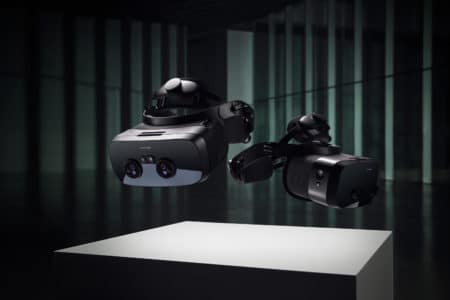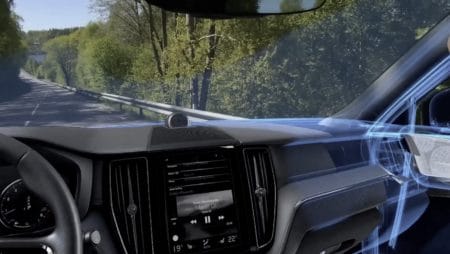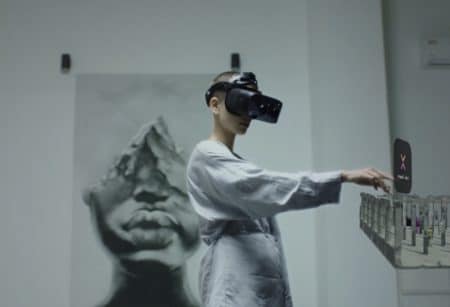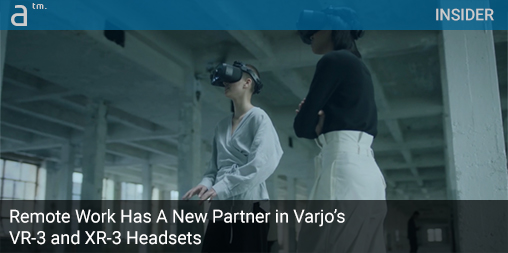DURING THE GLOBAL PANDEMIC, remote design teams that typically met in person for critical junctures in their workflows were suddenly no longer able to do so. Unable to get on planes and enter countries far away, these designers and engineers had to alter their collaboration strategies. They turned to virtual and mixed-realities.
Enter Varjo
To work at the same fidelities as real life with human eyes, there are few options in the market with the technical competencies of Finnish VR-XR headset maker Varjo. The company’s latest headsets began shipping worldwide this past March, into a global pandemic context that still has many enterprise companies working remotely and limiting business travel.
All the materials are super hygienic and they also support UV cabinets for Covid cleaning.
“Customers are using our headsets for multi-hour simulations and collaborative sessions,” says Urho Konttori, co-founder and chief innovation officer, Varjo, when mentioning improvements made to the comfort and usability of the VR-3 and XR-3 over prior generations of the devices. (Image 01) In this pandemic context—which may continue for a year or more—travel is more limited. “Design reviews used to be once a month in Korea,” says Konttori when speaking of device user Kia. “Now, they meet for extended [virtual] sessions.”
The new 3-point precision fit headband offers a 40 percent lighter weight than the previous unit and includes active cooling. “We redesigned the head strap to take the weight away from the forehead and reduce pressure,” Konttori adds, noting that other VR headsets often place too much pressure on the forehead for long-session comfort. And the ultra-wide optical design aids in removing eye strain and simulator sickness, crucial for long-session simulation training using the XR-3. (Image 01)

01 – Varjo’s new XR-3 (left) and VR-3 (right) headsets bring twice the performance and lower costs, enabling more professionals to embrace the leading edge of VR/XR technologies. (click on image to see larger)
In the pandemic context having VR/XR headsets be far more comfortable is a critical feature, but not the only one. Cleaning the device is now very important. “All the materials are super hygienic,” he adds, “and they also support UV cabinets for Covid cleaning.” With these improvements and the advancements in ergonomics, Varjo believes their VR-3 and XR-3 are the industry’s best devices for virtual reality and mixed-reality long-form sessions and simulations.
Full-Frame Bionic Display
Varjo’s ground-breaking innovation has always been its patented Bionic Display(TM) technology, delivering the world’s only VR with human-eye resolution. With the latest VR-3 and XR-3 headsets, the company has brought its Bionic Display technology full-frame.
In earlier models, the human-eye resolution section was contained in a smaller center section of the display. The system still uses two different displays, a 70 PPD micro OLED 1920 x 1920 retina level (human eye) display for the Focused area (same as the earlier model) and a 30 PPD LCD 2880 x 2720 display for the Peripheral area—much larger than the previous generation’s 1440 x 1600 AMOLED display. (Image 02)

02 – Varjo’s Bionic (Human Eye Resolution) Display technology is shown on right compared to the typical consumer VR headset display resolution shown on left. The resolution is so life-like that Varjo has quickly established itself as the industry leader for virtual simulation markets in aerospace, medicine, and industrial applications. (click on image to see larger)
Software and hardware optically combine both displays into the game-changing full-frame Bionic Display in the VR-3 and XR-3 headsets, resulting in twice the previous models’ performance. Enhancing the Bionic Display further is a larger 115-degree field of view (FoV). And the XR-3 has all new lenses. Additionally, the XR-3 and VR-3 have the world’s fastest and most accurate eye-tracking capabilities, via integrated Ultraleap technology, up to 200Hz, giving users optimized visual fidelity through foveated rendering.
New Lidar
The XR-3 introduces, for the first time, new integrated Lidar technology into the headset. With the industry’s first depth awareness in a VR/MR/XR headset, the XR-3 merges Lidar and stereo RGB video pass-through to deliver seamless merging of the real and virtual worlds for perfect occlusion and full 3D world reconstruction. The company uses NVIDIA’s deep neural technologies, which are useful for depth data in downstream applications.
The XR-3 also features inside-out tracking, which allows the user to establish the precise position of the XR-3 within an environment. This vastly improves tracking accuracy and removes the need for SteamVR base stations.
Markets and Compatibilities
The XR-3 is a key component of Varjo’s simulations market business, grounded in the defense, aerospace, and medical industries. With Varjo’s first headset (VR-1) and its successors on the market for almost four years now, training and simulation have emerged as its strongest market. The automobile design market is also where Varjo excels, with a strategic partnership with Volvo, made a few years ago.
When you put on the headset, the optics move to the center of your eyes, and can provide analytics on what you are looking at…running at 200Hz, which is over the threshold of medical-grade.
“High-fidelity is critical for effective mixed reality training for pilots, says Chris Metel, Prepar3D Engineering Program Manager, Lockheed Martin. “Support With the Varjo XR-3, the realism is further increased in Prepar3D, which removes negative training when recreating conditions of the most mission-critical scenarios. Prepar3D v5.1 supports the Varjo XR-3 out of the box, giving all types of pilots an affordable and agile option for training.”
Varjo’s technology includes eye-tracking. “When you put on the headset, the optics move to the center of your eyes,” adds Konttori, “and can provide analytics on what you are looking at…running at 200Hz, which is over the threshold of medical grade.” This type of innovation has led Varjo to market leadership in simulation and is why companies like Lockheed Martin have become enthusiastic users of Varjo’s technologies.

03 – A screen capture from a Varjo user video—this one from Volvo wherein a test vehicle has a projected virtual dashboard that the actual test driver can only see because they are wearing the XR-3 headset with real-time pass-through video. Part of the virtual dashboard is rendered in blue wireframe (right side).
Varjo’s headsets are compatible with all leading VR software tools. “All other software for VR works with VR-3 says,” Konttori, “including Enscape, Twinmotion, Unreal, and others.” The VR-3 and XR-3 are also open standards-compliant and support The Khronos Group’s OpenXR and OpenVR technology standards. The latter has the widest industry adoption. While Varjo’s headsets are not for gamers, technically, they would work. “The people who design the games, in an immersive space, may choose to work out their games from within them,” he adds.
Still, that’s not where Varjo has its prime market interests. Konttori acknowledges that Varjo’s headsets are not aimed at high-volume markets. Still, its innovation ambitions bode well for the vast market of architects, designers, and engineers currently using lesser-grade technologies. “Our goal was we wanted to deliver twice the performance at half the price,” he says, adding, “the price point today is one that can start to democratize this kind of technology.”
And that is exactly the good news numerous industries would want to hear, given the extended post-pandemic context that is likely to make virtual meetings and remote collaborative work a part of normal life going forward.
Reality Cloud
With the VR-3 and XR-3 devices just starting shipping at end of the first quarter this year, the company has already made exciting announcements about its future with the introduction of the Varjo Reality Cloud and ground-breaking teleportation technologies.

04 – An architect in California, for example, can enter a building site and put on the XR-3, and stream her reality to anyone else in the world in real-time using Varjo’s latest technologies. Reality Cloud coming later this year will make this possible.
While these technologies will likely not emerge for full use until 2022, the Reality Cloud and Varjo’s proprietary algorithms have enabled for the first time the ability to virtually teleport any XR-3 user to another location in the world to another XR-3 user and be fully embedded in the first user’s physical environment along with digital 3D virtual immersive imagery. (Images 04 – 06)

05 – A client or collaborator someplace else in the world (eg: Japan) can be teleported to the place (environment) of the California architect. Wearing the XR-3 device plus the technology of Reality Cloud, this second person can be teleported virtually to another place on Earth. (see next image)
An architect in Los Angeles could invite a client currently in Japan to the location of a building site in California, for example, where the architect wearing the XR-3 could enable the client wearing a VR-3 or XR-3 headset to “virtually teleport” the architect’s location. (Images 04-06). The architect’s XR-3 headset would capture its environment with its onboard cameras and LiDAR sensors and stream that data to the Reality Cloud where it would then be streamed down to the client in Japan. (Image 04) Varjo’s proprietary streaming algorithms make the stream into a single megabyte per second (similar to a Netflix movie) live 3D video feed. The client in Japan can virtually occupy the same environment the architect in California is capturing in real-time.

06 – This screen capture image from Varjo’s technology video illustrates that the two XR-3 wearing users can occupy the same space, the second person being teleported to the first person’s location where the XR-3 captures its surroundings and streams them via Reality Cloud to anywhere in the world.
The low-latency video pass-through technology is some of the strongest technology the Finnish company has created, and it gets fused with fully occluded virtual 3D imagery—making it possible for the architect in California to composite digital building elements (eg: BIM object information) over the live 3D actualized building elements all in real-time.
The Future
Varjo isn’t just the most advanced VR/XR headset maker in the world, they possess a significant engaged customer base consisting of world-class global industry leaders. With the June announcement of virtual teleportation and Reality Cloud, Varjo also announced the acquisition of Norwegian company Dimension10, which is an industry leader in deploying VR technologies within AEC industries. Despite having companies like Foster + Partners among its early architect users, Varjo’s AEC market presence has lagged that of other devices like Oculus, HTC Vive, and Microsoft Hololens. But this may change soon—and be accelerated in the lingering Covid pandemic context—as the company leverages and integrates Dimension10 product offerings and technologies with Reality Cloud and their ground-breaking VR/XR headsets.




Reader Comments
Comments for this story are closed